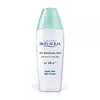What's inside
What's inside
 Key Ingredients
Key Ingredients

 Benefits
Benefits

 Concerns
Concerns

 Ingredients Side-by-side
Ingredients Side-by-side

Water
Skin ConditioningEthyl Methoxycinnamate
UV AbsorberMethylene Bis-Benzotriazolyl Tetramethylbutylphenol
UV FilterCyclopentasiloxane
EmollientGlycerin
HumectantEthylhexyl Triazone
UV AbsorberPolysorbate 60
EmulsifyingDiethylamino Hydroxybenzoyl Hexyl Benzoate
UV FilterBetaine
HumectantPhenoxyethanol
PreservativeAmmonium Acryloyldimethyltaurate/Vp Copolymer
Acrylates/C10-30 Alkyl Acrylate Crosspolymer
Emulsion StabilisingHydrogenated Lecithin
EmulsifyingTriethanolamine
BufferingPanthenol
Skin ConditioningDisodium EDTA
Methylparaben
PreservativePropylparaben
PreservativeSodium Hyaluronate
HumectantDipotassium Glycyrrhizate
HumectantSodium Acetylated Hyaluronate
HumectantArginine
MaskingHydrolyzed Collagen
EmollientTetrahexyldecyl Ascorbate
AntioxidantTocopheryl Acetate
AntioxidantWater, Ethyl Methoxycinnamate, Methylene Bis-Benzotriazolyl Tetramethylbutylphenol, Cyclopentasiloxane, Glycerin, Ethylhexyl Triazone, Polysorbate 60, Diethylamino Hydroxybenzoyl Hexyl Benzoate, Betaine, Phenoxyethanol, Ammonium Acryloyldimethyltaurate/Vp Copolymer, Acrylates/C10-30 Alkyl Acrylate Crosspolymer, Hydrogenated Lecithin, Triethanolamine, Panthenol, Disodium EDTA, Methylparaben, Propylparaben, Sodium Hyaluronate, Dipotassium Glycyrrhizate, Sodium Acetylated Hyaluronate, Arginine, Hydrolyzed Collagen, Tetrahexyldecyl Ascorbate, Tocopheryl Acetate
Cyclopentasiloxane
EmollientWater
Skin ConditioningEthylhexyl Methoxycinnamate
UV AbsorberZinc Oxide
Cosmetic ColorantTriethylhexanoin
MaskingDiglycerin
HumectantTitanium Dioxide
Cosmetic ColorantMethyl Methacrylate Crosspolymer
Trimethylsiloxysilicate
EmollientDiethylamino Hydroxybenzoyl Hexyl Benzoate
UV FilterSodium Hyaluronate
HumectantTocopheryl Acetate
AntioxidantSodium Ascorbyl Phosphate
AntioxidantGlycyrrhetinic Acid
Skin ConditioningLauryl PEG-9 Polydimethylsiloxyethyl Dimethicone
Skin ConditioningSilica
AbrasiveHydrogen Dimethicone
Polyglyceryl-2 Triisostearate
Emulsifying1,2-Hexanediol
Skin ConditioningMethylparaben
PreservativeAluminum Hydroxide
EmollientPanthenol
Skin ConditioningVinyl Dimethicone/Lauryl Dimethicone Crosspolymer
Disodium EDTA
Cyclopentasiloxane, Water, Ethylhexyl Methoxycinnamate, Zinc Oxide, Triethylhexanoin, Diglycerin, Titanium Dioxide, Methyl Methacrylate Crosspolymer, Trimethylsiloxysilicate, Diethylamino Hydroxybenzoyl Hexyl Benzoate, Sodium Hyaluronate, Tocopheryl Acetate, Sodium Ascorbyl Phosphate, Glycyrrhetinic Acid, Lauryl PEG-9 Polydimethylsiloxyethyl Dimethicone, Silica, Hydrogen Dimethicone, Polyglyceryl-2 Triisostearate, 1,2-Hexanediol, Methylparaben, Aluminum Hydroxide, Panthenol, Vinyl Dimethicone/Lauryl Dimethicone Crosspolymer, Disodium EDTA
Ingredients Explained
These ingredients are found in both products.
Ingredients higher up in an ingredient list are typically present in a larger amount.
Cyclopentasiloxane, or D5, is a silicone used to improve texture of products and trap moisture.
D5 is considered lightweight and volatile. Volatile means it evaporates quickly after application. Once evaporated, D5 leaves a thin barrier that helps keep skin hydrated.
It is also an emollient. Emollients help soften the skin and prevent water loss. Silicones create a silky texture in products. D5 helps other ingredients become more spreadable.
Studies show D5 is safe to use in skincare products. We recommend speaking with a skincare professional if you have concerns.
Learn more about CyclopentasiloxaneDiethylamino Hydroxybenzoyl Hexyl Benzoate (DHHB) is a chemical UV-A absorber. It is formulated for high UVA protection (320-400 nm).
DHHB is well-liked for:
DHHB has been approved by the EU, Japan, Taiwan, and South America for use up to 10%. Unfortunately, it has not been approved for use in the US or Canada due to slow regulatory processes.
This ingredient is soluble in oils, fats, and lipids.
Learn more about Diethylamino Hydroxybenzoyl Hexyl BenzoateDisodium EDTA plays a role in making products more stable by aiding other preservatives.
It is a chelating agent, meaning it neutralizes metal ions that may be found in a product.
Disodium EDTA is a salt of edetic acid and is found to be safe in cosmetic ingredients.
Learn more about Disodium EDTAMethylparaben is a preservative and is a paraben. It is used to prevent the growth of fungus, mold, and other harmful bacteria. Parabens are chemicals used as preservatives in both cosmetics and food.
Methylparaben can be synthetically created. It can also be found naturally in some fruits, such as blueberries.
Oftentimes, Methylparaben is combined with other parabens to help increase the shelf life.
The safety of Methylparaben is currently being studied. While ongoing studies are looking into the safety of parabens, the results have been very mixed. Some studies have not found Methylparaben to be harmful.
Learn more about MethylparabenPanthenol is a common ingredient that helps hydrate and soothe the skin. It is found naturally in our skin and hair.
There are two forms of panthenol: D and L.
D-panthenol is also known as dexpanthenol. Most cosmetics use dexpanthenol or a mixture of D and L-panthenol.
Panthenol is famous due to its ability to go deeper into the skin's layers. Using this ingredient has numerous pros (and no cons):
Like hyaluronic acid, panthenol is a humectant. Humectants are able to bind and hold large amounts of water to keep skin hydrated.
This ingredient works well for wound healing. It works by increasing tissue in the wound and helps close open wounds.
Once oxidized, panthenol converts to pantothenic acid. Panthothenic acid is found in all living cells.
This ingredient is also referred to as pro-vitamin B5.
Learn more about PanthenolSodium Hyaluronate is hyaluronic acid's salt form. It is commonly derived from the sodium salt of hyaluronic acid.
Like hyaluronic acid, it is great at holding water and acts as a humectant. This makes it a great skin hydrating ingredient.
Sodium Hyaluronate is naturally occurring in our bodies and is mostly found in eye fluid and joints.
These are some other common types of Hyaluronic Acid:
Learn more about Sodium HyaluronateTocopheryl Acetate is AKA Vitamin E. It is an antioxidant and protects your skin from free radicals. Free radicals damage the skin by breaking down collagen.
One study found using Tocopheryl Acetate with Vitamin C decreased the number of sunburned cells.
Tocopheryl Acetate is commonly found in both skincare and dietary supplements.
Learn more about Tocopheryl AcetateWater. It's the most common cosmetic ingredient of all. You'll usually see it at the top of ingredient lists, meaning that it makes up the largest part of the product.
So why is it so popular? Water most often acts as a solvent - this means that it helps dissolve other ingredients into the formulation.
You'll also recognize water as that liquid we all need to stay alive. If you see this, drink a glass of water. Stay hydrated!
Learn more about Water